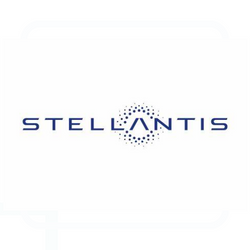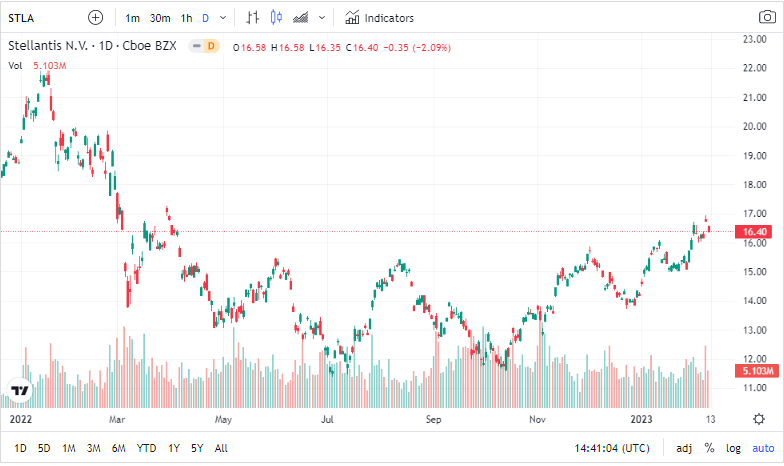This content represents the writer’s opinions and research and is not intended to be taken as financial advice. The information presented is general in nature and may not meet the specific needs of any individual or entity. It is not intended to be relied upon as a professional or financial decision-making tool.

Stellantis N.V. is a multinational automotive manufacturing corporation, established in January 2021, on the basis of a 50/50 cross-border merger between the Italian-American conglomerate Fiat Chrysler Automobiles (FCA) and the French Peugeot S.A. (PSA Group). The newly formed company is headquartered in the Netherlands. It is a leading global automaker and mobility provider that offers clean, connected, affordable and safe mobility solutions.
The company is engaged in the design, manufacture, distribution, and sale of vehicles. It offers its products under the following brand names: Abarth, Alfa Romeo, Chrysler, Citroën, Dodge, DS, Fiat, Jeep, Lancia, Maserati, Opel, Peugeot, Ram and Vauxhall. It operates through the following geographical regions: North America, South America, Enlarged Europe, Middle East and Africa, and China, India and Asia Pacific. The new company’s executive team is led by Carlos Tavares, who is appointed as Chief Executive Officer of Stellantis since January 2021.
The shares of Stellantis N.V. are listed on the New York Stock Exchange (NYSE) and are traded with the ticker symbol of STLA. Its market capitalisation is around USD 46.5 billion as of now, hence it is classified as a large-cap company.
The largest shareholders of Stellantis include Exor N.V., Peugeot Family, Dongfeng Motor Group, Bpifrance Group, Tiger Global Management, Amundi Asset Management, The Vanguard Group, Goldman Sachs Group, Deutsche Bank, Bank of Italy, Alliancebernstein, which combined own around 46% of the company shares.
Table of Contents
Stellantis Stock Forecast 2023
Stellantis reported its third quarter (Q3) earnings on 3rd November 2022. According to the announcements, the company’s net revenues amounted to USD 41.3 billion for the quarter, topping analyst expectations of USD 40.1 billion – an increase of +29%, if compared to the same period of 2021. At the same time, the most recent EPS is reported to be USD 5.12 and the company has sufficient reserves of free cash to deploy moving forward with its ambitious production, sales and ESG plans for 2023 and beyond.
Globally, the vehicle shipments of the group hit 1.3 million units, a 13% increase compared to the previous year’s Q3, primarily due to improvements in semiconductor order fulfilment. Shipments and net revenues were up in each of the company’s global regions. In North America, shipments were up 12% and net revenues gained 36% for the quarter, although the company lost a bit of its market share in the United States.
Compared to Q3 2021, the sales of battery electric vehicles (BEVs) rose by nearly 42% to 68,000 units in all operational regions combined. Logistical issues caused an increase in the group’s vehicle inventory stock, while overall dealer sales to final customers moved down around 4% in the quarter. The reason behind this is a challenge faced by the whole automotive industry – scarcity of delivery trucks and drivers, which causes difficulties in timely shipments. However, according to the company’s statement during its last earnings announcement, it currently sees “no red-light flashing” on possible energy constraints and delivery side issues affecting its supply chain negatively, thus the current level of concern is lower than at the end of the previous quarter.
At the Paris Motor Show in October, the company unveiled its new Jeep Avenger, the brand’s first fully electric vehicle, which is headed to the European market early next year. That’s also when the company announced that it will soon start taking orders for two electric models coming to North America, the Jeep Recon and the Wagoneer S, which are planned for production in 2024. Another part of the corporation, the Ram Trucks also plans to present its electric pickup concept at the Consumer Electronics Show of Las Vegas in January 2023.
Moving forward, in order to meet the globally growing demand for electrified vehicles, Stellantis announced a new agreement with joint-venture partner Punch Powertrain to increase production of the future-generation electrified dual-clutch transmissions (eDCT) for Stellantis hybrid and plug-in hybrid electric vehicles. The eDCTs, which will be built at the company’s Mirafiori complex in Italy, will complement the existing capacity in France. Expected to open in 2023, this new facility will also become the first circular economy hub for Stellantis, where three important activities for the sustainable use of vehicles and parts will be launched: vehicle reconditioning, dismantling and remanufacturing of spare parts.
Recently, Stellantis revealed that it has built one of the biggest and widest collaborative ecosystems in the world, with more than 160 co-funded projects and over 1,000 different partners worldwide. The projects align with Stellantis’ strategic technical domains, which include autonomous driving, connectivity, manufacturing, electrification technologies and advanced propulsion. Parallelly, driven by its Dare Forward 2030 program, the company aims at reaching carbon net zero emissions by 2038, as well as achieving 100% of sales in Europe and 50% in the United States being BEVs by the end of this decade.
Currently, various valuation metrics show that Stellantis is notably undervalued. It has a value score of “A” according to Zacks, which indicates that it would be a good pick for value investors. The financial health and growth prospects of STLA demonstrate its potential to outperform the market in the short to mid-run. The forecasts of the stock price range between USD 15 to USD 16.50 towards the end of FY 2023, whereas longer-term projections of the fair value for STLA reach levels of over USD 55 per piece according to some estimates.
The company’s average dividend yield of 7.15% (for the last 12 months) is notably higher than the US industry average of 3.14% and the total market average of 3.92%. Moreover, Stellantis reported a dividend yield of 7.7% for Q3 2022, more than +0.5% above its own annual average. This provides for yet another hint that its stock is fairly undervalued at the moment.
Additionally, the Wall Street equities research analysts have regularly issued “buy”, “hold” and “sell” ratings for Stellantis, since the beginning of this year. As of now, there are 5 holds and 7 buy ratings for this stock, thus the current consensus among Wall Street equity analysts is that investors should add the STLA shares to their portfolios.
Summarizing, it should be stated that the impact of these elements can have a positive impact on Stellantis stock price prospects for the next year and beyond, making it a potential candidate to be added to individual and corporate investment portfolios.
Stellantis Stock 2022
The automaker presented robust earnings pictures for both – the first half (H1) of the year and the third quarter of FY 2022. The company said it made USD 8 billion in net profit (or +34%), with an adjusted operating income margin of 14% (up from 11%) during H1, if compared to the same period of the previous year. The positive numbers of Q3 results have already been highlighted in the previous section.
Starting the year off at USD 19.54 per share, STLA has dropped by -25.1% to USD 14.64 as of 12th December, although there was no major negative news related to the automaker itself along the way. Thus, the trend was mostly driven by the overall market volatility and downslide through the year, resulting in a -15.85% based on the S&P 500 as a measurement indicator (as of the same date). On 12th January 2022, STLA reached its all-time high of USD 21.59 per share since the merger and establishment of the new company back in early 2021.
The stock price declined by around -33.5% to USD 14.32 on 7th March, followed by a brief partial recovery to near USD mid-16 levels towards the end of Q1. From there, STLA reached its deepest point so far for the FY 2022 on 5th July, finishing the day at USD 11.57 per piece. With ups and downs through Q3 and to date, the stock price remained in the range between USD 12-15, expected to stabilize in the area of USD 14.8 by the year-end.

Stellantis Stock 2021
Since the new company was formed on 17th January 2021, the market players were in a “waiting mode” for news and evidence of financial performance results through the first year of its operation. Stellantis reported record results in H1 and for the fiscal year as a whole, accelerating the realization of merger synergies and further enhancing its commercial operations.
The automaker also unveiled its ambitious electrification and software development plans, announcing investments of over USD 30 billion by 2026 focusing on the areas of new battery technology, material and IT solutions. Indeed, these factors played an important role in boosting STLA from its lows of USD 15 per share right after the merger to the area of around USD 19.5, a nearly 30% gain from the end of January till year-end 2021, making it a truly solid first year for the company by all measures.
Conclusion
Headquartered near Amsterdam, Stellantis N.V. is the fourth-largest automaker by volume and third by revenue in the world. With a global workforce of around 400,000 Stellantis ranks behind Volkswagen, Renault-Nissan-Mitsubishi, and Toyota and ahead of General Motors, Hyundai and Ford.
The key fundamentals of the new company are robust, with its stock price currently fairly undervalued. This offers both – the value and growth investors a good opportunity to add this title to their investment portfolios. Additionally, the majority of the analysts covering STLA signal a buy rating at the moment, believing that the company and its stock have promising prospects in the mid- and long run. The forecasted price targets by FYs 2025 and 2027 are respectively USD 43 and 57 per share, according to some analysts.
FAQ
Is Stellantis N.V.’s stock currently a “buy”, “hold” or “sell”?
The majority of the Wall Street equities research analysts covering STLA have issued buy ratings for this stock, so the consensus among them now is that – investors eyeing Stellantis should add it to their portfolios at a current undervalued price for the stock.
Eventually, there are multiple factors that can positively impact the price prospects of STLA next year and beyond, as described in the first section of this article. Hence in our view, it is an interesting long-term investment.
Is STLA more attractive for value or growth investors?
Actually – for both, on the one hand, valuation metrics show the stock being significantly undervalued. On the other hand, the analysis of the company’s growth prospects shows that it has a strong potential to outperform its industry peers, as well as the market in general, in the mid- to long-term horizon.
Additionally, it offers a nice dividend yield of 7.7% on the basis of its promising Q3 2022 earnings results, which reinforces the conclusion of the stock price is undervalued at the moment.
WeInvests is a financial portal-based research agency. We do our utmost best to offer reliable and unbiased information about crypto, finance, trading and stocks. However, we do not offer financial advice and users should always carry out their own research.
Read More







